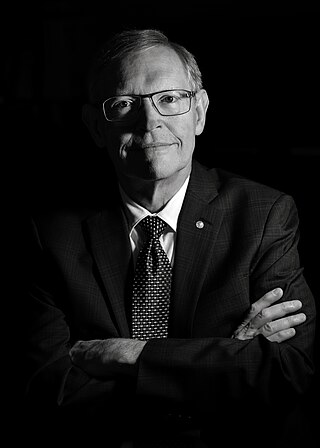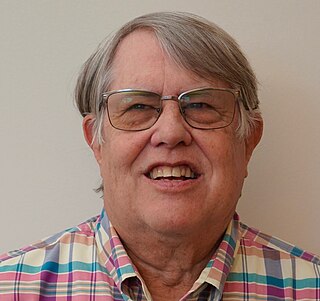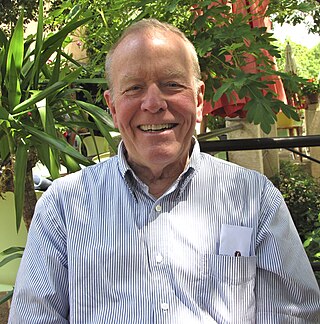Related Research Articles
In condensed matter physics, quantum hydrodynamics (QHD) is most generally the study of hydrodynamic-like systems which demonstrate quantum mechanical behavior. They arise in semiclassical mechanics in the study of metal and semiconductor devices, in which case being derived from the Boltzmann transport equation combined with Wigner quasiprobability distribution. In quantum chemistry they arise as solutions to chemical kinetic systems, in which case they are derived from the Schrödinger equation by way of Madelung equations.

Martin Karplus is an Austrian and American theoretical chemist. He is the Director of the Biophysical Chemistry Laboratory, a joint laboratory between the French National Center for Scientific Research and the University of Strasbourg, France. He is also the Theodore William Richards Professor of Chemistry, emeritus at Harvard University. Karplus received the 2013 Nobel Prize in Chemistry, together with Michael Levitt and Arieh Warshel, for "the development of multiscale models for complex chemical systems".

William Esco Moerner, also known as W. E. Moerner, is an American physical chemist and chemical physicist with current work in the biophysics and imaging of single molecules. He is credited with achieving the first optical detection and spectroscopy of a single molecule in condensed phases, along with his postdoc, Lothar Kador. Optical study of single molecules has subsequently become a widely used single-molecule experiment in chemistry, physics and biology. In 2014, he was awarded the Nobel Prize in Chemistry.
The quantum potential or quantum potentiality is a central concept of the de Broglie–Bohm formulation of quantum mechanics, introduced by David Bohm in 1952.

Edward Armand Guggenheim FRS was an English physical chemist, noted for his contributions to thermodynamics.

Ronnie Kosloff is a professor of theoretical chemistry at the Institute of Chemistry and Fritz Haber Center for Molecular Dynamics, Hebrew University of Jerusalem, Israel.

Eric Johnson "Rick" Heller is the Abbott and James Lawrence Professor of Chemistry and Professor of Physics at Harvard University. Heller is known for his work on time-dependent quantum mechanics, and also for producing digital art based on the results of his numerical calculations.
Paul Lyon Houston is Professor Emeritus of Chemistry at Cornell University and Professor Emeritus of Chemistry and Biochemistry at the Georgia Institute of Technology.
Aron Kuppermann was a professor of chemical physics at California Institute of Technology. The author of more than 200 publications, he is perhaps best known for his work in the application of quantum mechanics to the solution of problems in chemical reaction dynamics and kinetics. Kuppermann and George Schatz completed the first calculation of the dynamics of a chemical reaction in a full 3-dimensional quantum model.
Robert Eugene Wyatt is an emeritus Professor of Chemistry at the University of Texas at Austin, Department of Chemistry and Biochemistry.
Craig Callender is a professor of philosophy at the University of California, San Diego. His main areas of research are philosophy of science, philosophy of physics and metaphysics.

Donald Gene Truhlar is an American scientist working in theoretical and computational chemistry and chemical physics with special emphases on quantum mechanics and chemical dynamics.

James R. Chelikowsky is a professor of physics, chemical engineering, and chemistry at The University of Texas at Austin. He is the director of the Institute for Computational Engineering and Sciences' Center for Computational Materials. He holds the W.A. "Tex" Moncrief Jr. Chair of Computational Materials.

Yitzhak Apeloig is a pioneer in the computational chemistry field of the Ab initio quantum chemistry methods for predicting and preparing the physical and chemical properties of materials. He was the president of the Technion from 2001 until 2009 where the position was handed off to Peretz Lavie. Distinguished Prof. Apeloig currently holds the Joseph Israel Freund Chair in Chemistry and is the co-director of the Lise Meitner Minerva Center for Computational Quantum Chemistry at the Technion. He served as dean of the Faculty of Chemistry from 1995 to 1999, where he was named Teacher of the Year at three occasions.

James Bernhard Anderson was an American chemist and physicist. From 1995 to 2014 he was Evan Pugh Professor of Chemistry and Physics at the Pennsylvania State University. He specialized in Quantum Chemistry by Monte Carlo methods, molecular dynamics of reactive collisions, kinetics and mechanisms of gas phase reactions, and rare-event theory.

Bidyendu Mohan Deb is an Indian theoretical chemist, chemical physicist and a professor at the Indian Institute of Science Education and Research, Kolkata (IISER). he is known for his studies in theoretical chemistry and chemical physics. He is an elected fellow of the International Union of Pure and Applied Chemistry, The World Academy of Sciences, Indian National Science Academy and the Indian Academy of Sciences. The Council of Scientific and Industrial Research, the apex agency of the Government of India for scientific research, awarded him the Shanti Swarup Bhatnagar Prize for Science and Technology, one of the highest Indian science awards, in 1981, for his contributions to chemical sciences.

R. J. Dwayne Miller is a Canadian chemist and a professor at the University of Toronto. His focus is in physical chemistry and biophysics. He is most widely known for his work in ultrafast laser science, time-resolved spectroscopy, and the development of new femtosecond electron sources. His research has enabled real-time observation of atomic motions in materials during chemical processes and has shed light on the structure-function correlation that underlies biology.
Sandra J. Rosenthal is the Jack and Pamela Egan Professor of Chemistry, professor of physics and astronomy, pharmacology, chemical and biomolecular engineering, and materials science at Vanderbilt University. She is a joint faculty member at Oak Ridge National Laboratory in the Materials Science and Technology Division and the director of the Vanderbilt Institute of Nanoscale Science and Engineering.

David Joshua Tannor is a theoretical chemist, who is the Hermann Mayer Professorial Chair in the department of chemical physics at the Weizmann Institute of Science.
Anne Bowen McCoy is a theoretical chemist and her research interests include vibrational spectroscopy, hydrogen bonding, and charge-transfer bands.
References
- 1 2 3 4 Eric R. Bittner, Curriculum Vitae Archived 2011-10-02 at the Wayback Machine , University of Houston, downloaded 22. November 2011
- ↑ Recognition and awards Archived 2012-04-26 at the Wayback Machine , College of Natural Sciences and Mathematics, University of Houston, downloaded 23. November 2011
- ↑ Endowed Chairs & Professorships Archived 2012-05-10 at the Wayback Machine , University of Houston, downloaded 23. November 2011
- ↑ John and Rebecca Moores Professors Award History Archived 2012-08-05 at archive.today , Senior Vice President for Academic Affairs and Provost, University of Houston, downloaded 23. November 2011
- ↑ Author profile of Quantum Dynamics: Application in Biological and Materials Systems, downloaded 23. November 2011
- ↑ Eric R. Bittner, Department of Chemistry Archived 2021-08-05 at the Wayback Machine , University of Houston, downloaded 22. November, 2011
- ↑ Eric R. Bittner: 2007 Chemistry, Guggenheim Foundation, downloaded 23. November 2011
- ↑ "Alumni Awards".
- ↑ University of Houston, Division of Research: Research Update May/June 2012 [ permanent dead link ], downloaded 22. June 2012
- ↑ UH chemist named to Guggenheim Fellowship Houston Chronicle, April 25, 2007
- ↑ NSM Faculty Awards 2009, downloaded 23. November 2011
- ↑ Eric Bittner, publications and preprints list Archived 2011-10-02 at the Wayback Machine , downloaded 23. November 2011